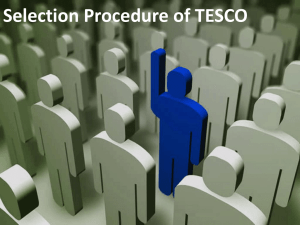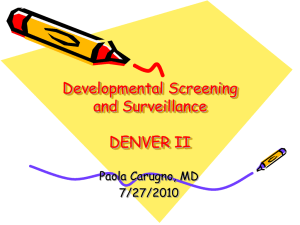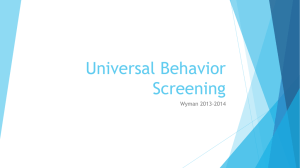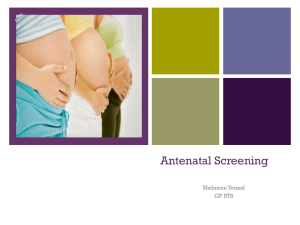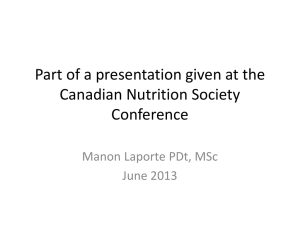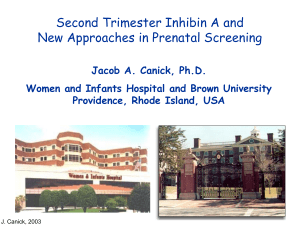Down`s syndrome screening
advertisement
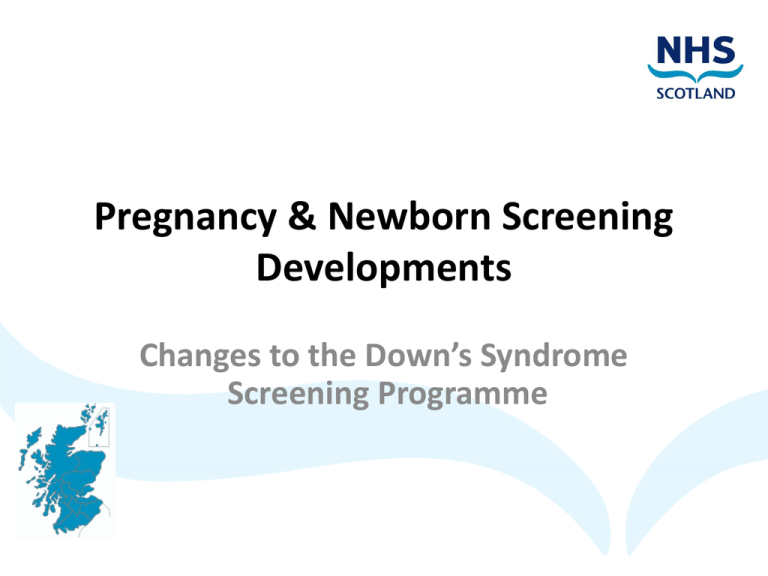
Pregnancy & Newborn Screening Developments Changes to the Down’s Syndrome Screening Programme What is screening? • Screening is a public health service in which members of a defined population, who do not necessarily perceive they are at risk of, or are already affected by a disease or its complications, are asked a question or offered a test, to identify those individuals who are more likely to be helped than harmed by further tests or treatment to reduce the risk of a disease or its complications UK National Screening Committee Screening for Down’s syndrome Screening Tests • Screening tests identify individuals as broadly ‘high’ or ‘low’ chance. High chance results do not indicate that the baby definitely has Down’s syndrome, but should prompt the health care professional to offer further screening or diagnostic tests Diagnostic Tests • Diagnostic tests for Down’s syndrome give definite information on fetal chromosomes by confirming the presence of a third copy of chromosome 21. Terminology Detection Rate (DR) • The proportion of women who will be identified by the screening test with an affected pregnancy False Positive Rate (FPR) • The proportion of women with a higher chance/screen positive result but have an unaffected pregnancy False Negative Rate (FNR) • The proportion of women who are given a lower chance result but have an affected pregnancy Multiples of the median • The serum marker concentration for a pregnant woman, divided by the median concentration value for unaffected pregnancies of the same gestational age Communicating chance Screening Markers First Trimester Serum Markers Pregnancy Associated Plasma Protein – A (PAPP – A) • • • • • Originates mainly from placental syncytiotrophoblast Concentration increases with gestation Screening sensitivity decreases with gestation Optimal sensitivity at 8 – 9 weeks gestation Levels reduced in pregnancies affected by Down’s syndrome First Trimester Serum Markers Free beta Human Chorionic Gonadotrophin (FßhCG) • • • • • Beta subunit of hCG/intact hCG Produced by the syncytiotrophoblast cells Decreases with gestational age Sensitivity maintained in second trimester Raised levels in pregnancies affected by Down’s syndrome Changes to meet new targets and standards To meet workload standards the four Down’s laboratory services in Scotland are being reconfigured on to two sites: • Glasgow (Yorkhill) serving West of Scotland – Including Highland & Western Isles • Edinburgh (Western General) serving East of Scotland – Including Orkney & Shetland First Trimester Screening • Pre-test discussion • Copy of Your Guide to Tests during Pregnancy (48 hrs before test) • Sign consent section of SWHMR (woman & midwife) • Women need to be aware that other conditions may be identified (Edwards, Patau’s) • Combined screening offered for all singleton pregnancies • Multiple pregnancies – NT measurement only First Trimester Screening Remember • Complete ALL sections on form • CHI mandatory (even if hospital no. still in use) • Ideally weight should be at time of test, but if booking weight used MUST be accurate • Record family origin as per Family Origin Questionnaire • If known – record type of assisted conception – Record age of donor if conceived through egg donation • Form must be signed by person taking blood sample • Sonographer MUST record their unique ID code (issued by lab) Nuchal Translucency • • • • Measured between 11 – 13 weeks 6 days CRL 42 -80 mm Must be as accurate as possible Take more than one image and record the maximum one that meets all criteria • If not possible to obtain NT measurement offer return appointment within 3 working days (provided still in gestational range) • If unable to obtain measurement at repeat – offer second trimester screening First Trimester Screening • NT measurement combined with results of serum markers • Results are converted to MoM and corrected for co-variables including maternal weight, smoking status, and if applicable, previous affected pregnancy • NT measurement and blood test performed on same day • Detection rate – 90% • False positive rate – 5% • This test does not screen for neural tube defects and the 18 – 21 week fetal anomaly scan is now the screening test of choice for these conditions Second Trimester Serum Screening Women who book too late for 1st trimester screening will be offered the quadruple test in the second trimester • • • • • • 15 weeks + 0 days – 20 weeks + 6 days Alpha-fetoprotein (AFP) Human Chorionic Gonadotrophin (Intact hCG) Unconjugated estriol (uE3) Inhibin-A Detection rate – 75% NB. Abnormal AFP results will continue to be reported Second Trimester Serum Screening Remember • • • • Use specific form for second trimester screening Complete ALL sections on the form Clotted samples are required DO NOT use bottles containing EDTA Clinical follow up If the screening test result indicates the woman is in the “higher chance” group she will be offered counselling and a diagnostic test • Amniocentesis – performed between 15 – 20 weeks • Chorionic villus sampling (CVS) – performed between 11 – 13 weeks Both of these diagnostic procedures carry a risk of miscarriage, quoted as 2% for CVS and 1% for amniocentesis by most hospitals. Information • Information needs to be given in a way that helps make it clear to the parents that the health professional recognises the impact the diagnosis will have on the parents • The diagnosis of abnormalities which are perceived by health professionals as ‘less severe’ than others still cause significant distress for parents (Statham, Solomou & Green, 2003) • For parents, the quality of the care they receive is crucial. Few forget their experience of loss. Most have vivid memories of what happened, what was done and what was said and these memories may stay with them for months, years and often a lifetime to come • For further information go to: https://fetalanomaly.screening.nhs.uk/CEMT21/ Useful Web Sites www.pnsd.scot.nhs.uk www.screening.nhs.uk/ www.fetalanomaly.screening.nhs.uk/ www.dsscotland.org.uk/ www.scotgen.org.uk/ www.healthtalkonline.org/Pregnancy_children/ www.arc-uk.org/
